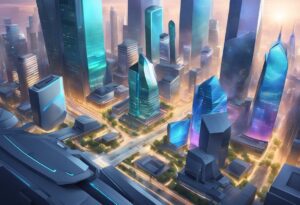Metaverse lands have become a hot topic in recent years as virtual worlds have gained popularity. Virtual land ownership in the metaverse has become a lucrative business, with some investors making millions of dollars from buying and selling virtual real estate.
One of the most popular metaverse platforms for virtual land ownership is Decentraland, a decentralized virtual world that is built, governed, and owned by its users. In Decentraland, users can buy virtual land, or LAND, which they can then use to build and create their own virtual experiences. The value of LAND in Decentraland is determined by supply and demand, with some prime locations selling for millions of dollars.
Investing in metaverse lands is not just limited to Decentraland, however. Other virtual worlds, such as The Sandbox and Somnium Space, also offer virtual land ownership opportunities. As the metaverse continues to grow and evolve, virtual land ownership is likely to become an even more important aspect of the digital economy.
What are Lands in Metaverse?
Metaverse lands are virtual plots of land that can be bought, sold, and owned by users in the Metaverse. These virtual lands are limited in number and are represented by non-fungible tokens (NFTs) that are unique to each land. Users can interact with the virtual world, attend events, and even build structures on their land.
Total Number of Lands in the Metaverse
The exact number of lands in the Metaverse is difficult to determine as it is spread across multiple platforms. However, some of the popular Metaverse platforms include Decentraland, The Sandbox, and Somnium Space. These platforms have a limited number of lands available for purchase, making them a valuable asset in the virtual world.
Cost of Land in the Metaverse
The cost of land in the Metaverse varies depending on the platform and the location of the land. The price of land can range from a few dollars to thousands of dollars, with some prime locations selling for millions of dollars. The cost of land is determined by the demand and popularity of the platform, as well as the size and location of the land.
Best Place to Buy
The best place to buy Metaverse land depends on the user’s preference and budget. Decentraland, The Sandbox, and Somnium Space are some of the popular platforms to purchase virtual land. Each platform has its unique features and community, making it important for users to research and compare before making a purchase.
Purpose of Lands in the Metaverse
Metaverse lands serve multiple purposes, including socializing, gaming, and business. Users can attend virtual events, interact with other users, and even build structures on their land. Virtual lands can also be used for business purposes, such as hosting virtual conferences or selling virtual goods.
How it Works
Metaverse lands are represented by NFTs that are unique to each land. Users can purchase these NFTs using cryptocurrency and then claim ownership of the virtual land. The land can then be accessed through the Metaverse platform, where users can interact with the virtual world and other users.
Metaverse Land Uses
Metaverse lands can be used for a variety of purposes, including gaming, socializing, and business. Users can build structures, host events, and even sell virtual goods on their land. The virtual world offers endless possibilities, making it an exciting space for users to explore and create.

Metaverse Real Estate Fundamentals
Types of Virtual Land
In the metaverse, virtual land can be divided into two categories: public and private. Public land is owned by the platform and is available to all users. Private land is owned by individuals or organizations and is acquired through purchase or auction. The value of virtual land is determined by its location, size, and proximity to other valuable assets.
Some metaverse platforms, such as Decentraland and The Sandbox, allow users to create and customize their virtual land. This feature provides users with opportunities to create unique experiences and monetize their assets.
Virtual Land Ownership
Ownership of virtual land is established through the use of non-fungible tokens (NFTs). NFTs are digital assets that are unique and cannot be replicated. They are used to represent ownership of virtual land in the metaverse.
Virtual land ownership provides users with investment opportunities and the ability to generate revenue through the sale or rental of their assets. The virtual land ownership can provide users with a sense of ownership and control over their digital property.
Virtual real estate is a growing asset class in the metaverse. The ownership of digital real estate provides users with investment opportunities and the ability to generate revenue through the sale or rental of their assets. The value of virtual land is determined by its location, size, and proximity to other valuable assets.
Investing in Metaverse Lands
Investing in Metaverse Lands is a new and exciting way to invest in the future of digital assets. With the rise of NFTs and cryptocurrency, the metaverse is becoming an increasingly popular investment opportunity. In this section, we will explore the marketplaces and platforms available for investing in metaverse lands, as well as the risks and considerations that come with this type of investment.
Marketplaces and Platforms
There are several marketplaces and platforms available for buying and selling metaverse lands. OpenSea is one of the most popular marketplaces for NFTs, including metaverse lands.
Decentraland is a popular platform for buying and selling virtual lands using their native cryptocurrency, MANA. Ethereum is another popular platform for investing in metaverse lands, with several decentralized applications (dApps) available for trading NFTs.
Risks and Considerations
As with any investment, there are risks and considerations to keep in mind when investing in metaverse lands. One of the biggest risks is the volatility of cryptocurrency and NFTs. The value of these assets can fluctuate rapidly, making it difficult to predict the return on investment. The metaverse is still a relatively new and untested market, making it difficult to predict its long-term viability.
Investors should also consider the cost of buying and maintaining metaverse lands. While the initial purchase price may be low, there may be additional costs associated with maintaining the land, such as taxes and upkeep fees. It is important to research the market and the specific platform or marketplace before investing in metaverse lands.
Investing in metaverse lands can be an exciting and potentially lucrative opportunity for investors. However, it is important to approach this investment with caution and to carefully consider the risks and considerations before making any investment decisions.
Economic Aspects of Metaverse Lands
Monetization Strategies
Metaverse lands present a unique opportunity for businesses to monetize their virtual assets. Many businesses have already started marketing their products in the metaverse, allowing customers to purchase virtual goods for their virtual homes.
Furniture retailer West Elm is one such example, using metaverse technology to sell furniture to customers for their virtual homes.
Artificial scarcity is another monetization strategy that businesses can use to increase the value of their metaverse lands. By limiting the supply of virtual lands, businesses can create a sense of exclusivity and increase the demand for their virtual assets.
Supply and Demand Dynamics
The value of metaverse lands is determined by the principles of supply and demand. As the demand for virtual lands increases, the prices of these lands also increase. The scarcity of virtual lands can further drive up the prices of these assets.
The supply of virtual lands is limited, and this scarcity can lead to an increase in the value of these assets over time. Virtual lands can also be traded on virtual marketplaces, where buyers and sellers can negotiate prices based on the perceived value of these assets.
Businesses can use metaverse lands as a new revenue stream, and the scarcity of these assets can drive up their value over time. The principles of supply and demand govern the value of these assets, and businesses can use artificial scarcity to create a sense of exclusivity and increase the demand for their virtual lands.
Cultural and Social Impact
Communities and Collaboration
Metaverse lands have the potential to create a sense of community and collaboration among users. Virtual worlds such as Minecraft, Roblox, and Horizon Worlds allow users to create their own communities and socialize with others in a way that is not limited by physical boundaries.
The ability to collaborate on projects and share ideas with others from all over the world can lead to a more diverse and inclusive community. Users can create their own virtual events and activities, such as concerts and games, which can further strengthen the sense of community.
Virtual Events and Entertainment
Metaverse lands offer a new frontier for live events and entertainment. Users can attend virtual concerts, festivals, and other events from the comfort of their own homes. This creates a more accessible and inclusive experience for those who may not be able to attend in-person events due to physical or financial limitations.
Virtual events can be more environmentally friendly as they do not require the same level of resources as physical events. Users can also create their own virtual venues and landmarks, which can serve as a hub for socializing and entertainment.
Metaverse lands have the potential to create a more diverse, inclusive, and accessible community. The ability to collaborate on projects and attend virtual events can lead to a more connected and engaged user base. As the technology behind metaverse lands continues to evolve, it will be interesting to see how they impact various industries, including gaming, education, and entertainment.

Frequently Asked Questions
How can one purchase virtual real estate in the metaverse?
To purchase virtual real estate in the metaverse, users need to create an account on a metaverse platform that offers virtual land for sale. Once the account is set up, users can browse through the available land listings and make a purchase using the platform’s native cryptocurrency or other accepted payment methods.
What platforms offer the best selection of metaverse land for sale?
Several platforms offer virtual land for sale, including Decentraland, Somnium Space, and Voxels. Each platform has its own unique features and benefits, so users should research each platform before making a final selection.
What factors determine the value of land in virtual environments?
The value of virtual land in metaverse environments is determined by several factors, including location, size, and the level of development in the surrounding area. The popularity of the platform and the demand for virtual land can also affect the value.
Can users obtain virtual land for free in any metaverse platforms?
Some metaverse platforms offer free virtual land to users as a way to encourage participation and growth in the community. However, the availability of free land is often limited and may require users to meet certain criteria or participate in specific activities.
What are the potential investment returns on metaverse real estate?
The potential investment returns on metaverse real estate are difficult to predict and can vary widely depending on several factors, including the popularity of the platform, the demand for virtual land, and the level of development in the surrounding area. However, some investors believe that virtual real estate in the metaverse has the potential to appreciate in value over time.
How does the ownership of digital land work in decentralized platforms?
In decentralized platforms, ownership of digital land is recorded on a blockchain, which allows for a transparent and secure system of ownership.
Once a user purchases virtual land on a decentralized platform, they have complete control over the land, including the ability to develop and monetize it. However, ownership of virtual land in decentralized platforms is still a relatively new concept, and there may be legal and regulatory challenges that arise in the future.



